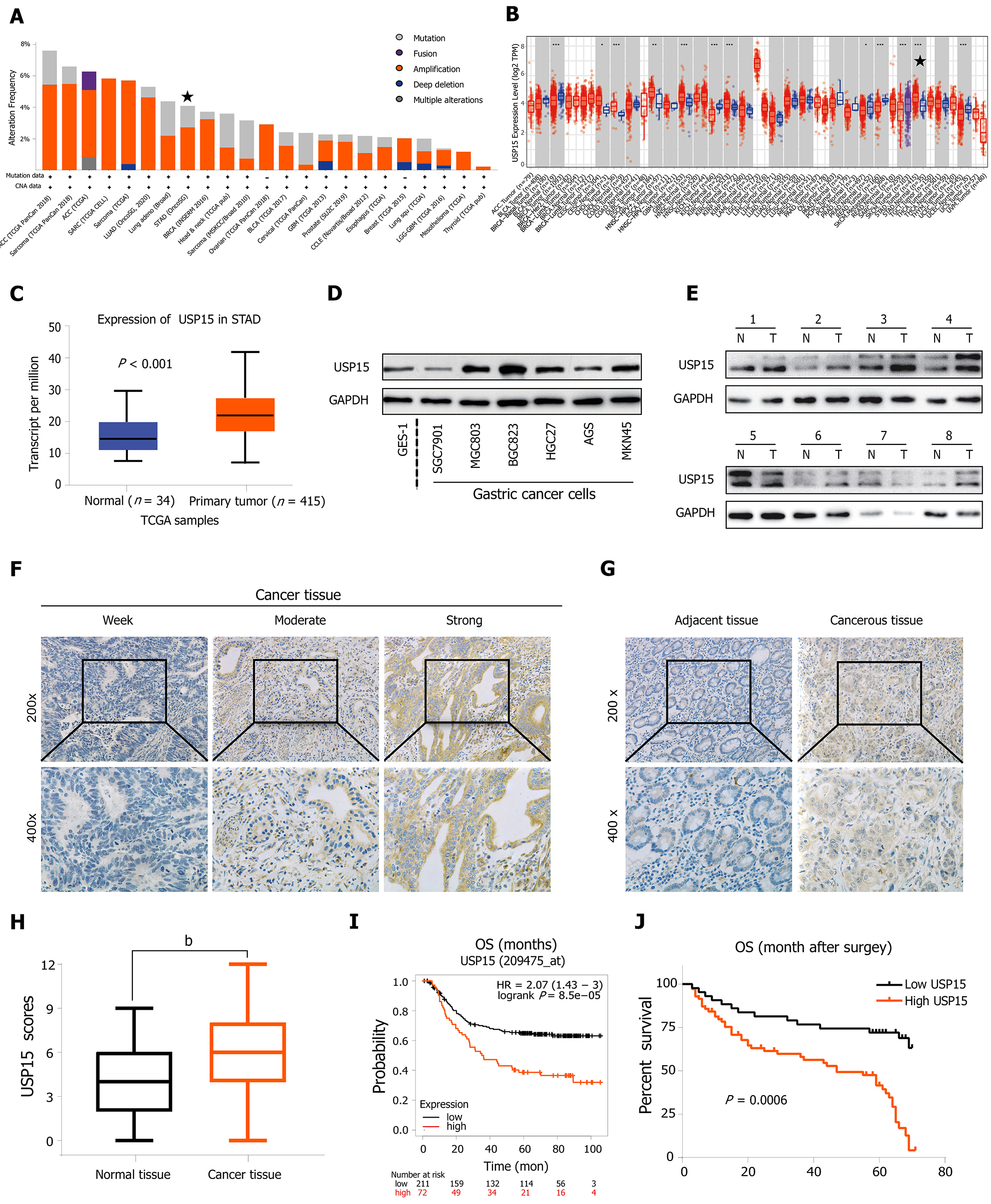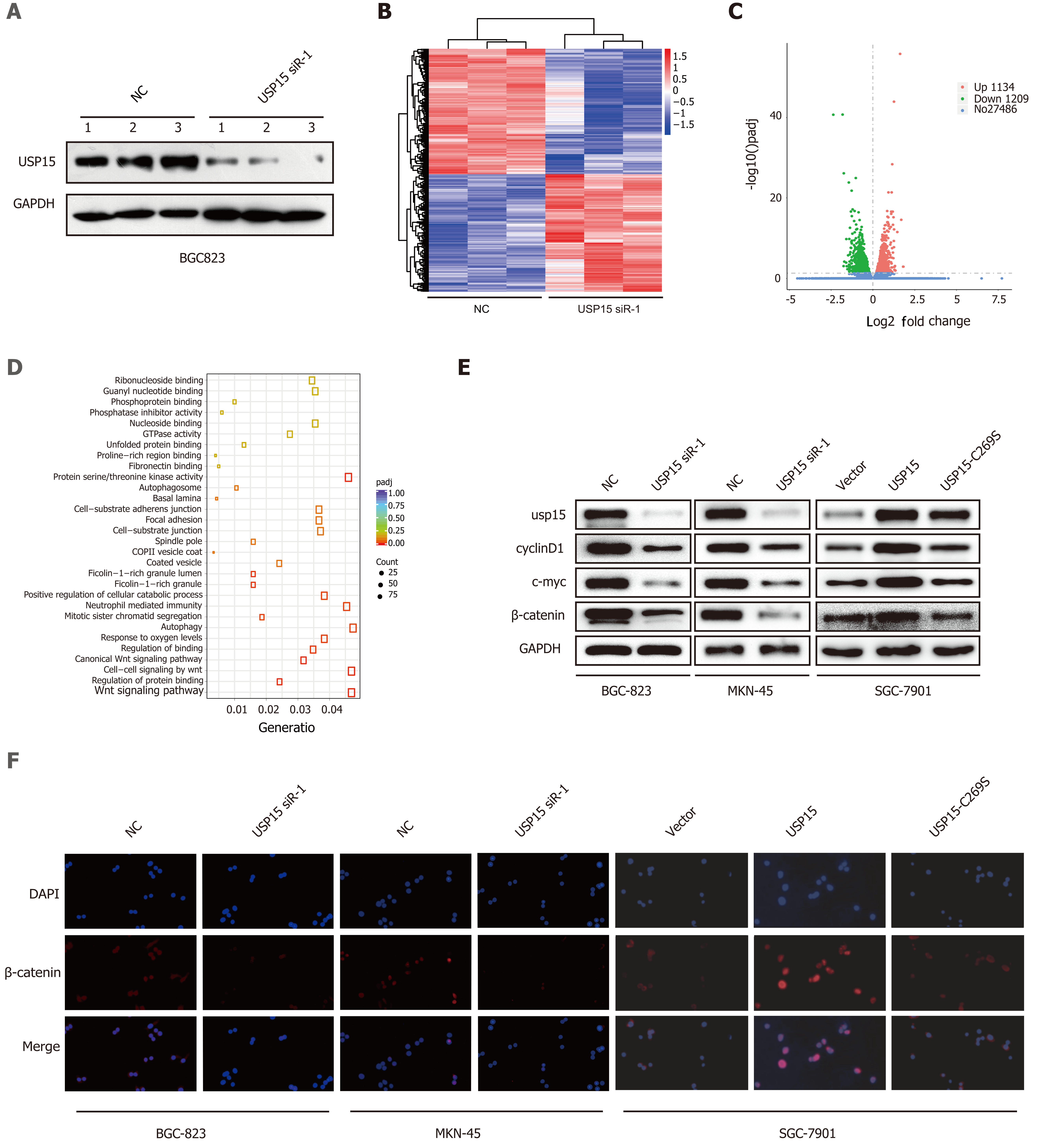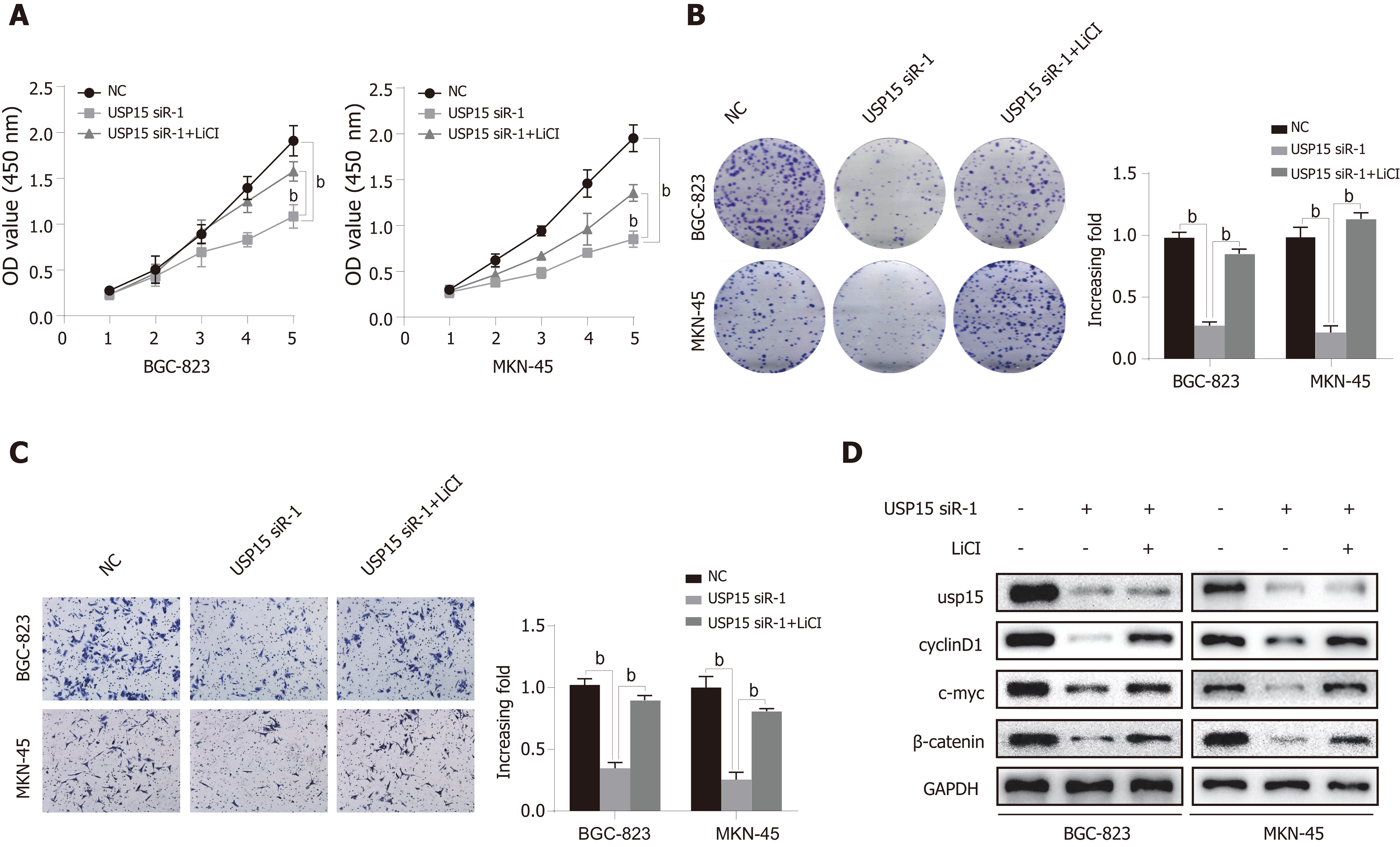Copyright
©The Author(s) 2021.
World J Gastroenterol. Jul 14, 2021; 27(26): 4221-4235
Published online Jul 14, 2021. doi: 10.3748/wjg.v27.i26.4221
Published online Jul 14, 2021. doi: 10.3748/wjg.v27.i26.4221
Figure 1 Ubiquitin-specific protease 15 is upregulated in gastric cancer cells and tissues, and is associated with a poor prognosis in gastric cancer patients.
A: Frequency of ubiquitin-specific protease 15 (USP15) in various cancers, including gastric cancer (GC). The data were derived from the cBioPortal for Cancer Genomics; B, C: USP15 mRNA expression level of cancer tissue and normal tissue in GC. Analysis of The Cancer Genome Atlas data from TIMER and UALCAN databases; D: Protein expression of USP15 in GES-1 cell line and GC cell lines; E: Protein expression of USP15 in GC tissue and adjacent noncancerous tissues (n = 8); F, G: Representative images of immunohistochemical staining of USP15 in human GC tissues and adjacent noncancerous tissues; H: USP15 staining scores of GC and normal tissues; I: Correlation between USP15 expression level and overall survival (OS) in GC patients obtained from Kaplan–Meier Plotter databases (209475_at, HR = 2.07 (1.43-3), log rank P = 8.5e−05); J: Kaplan–Meier curve stratified by USP15 expression in 115 GC patients (log-rank test, P = 0.0006). bP < 0.01, data were expressed as the mean ± standard error of the mean.
Figure 2 Knockdown of ubiquitin-specific protease 15 inhibits cell proliferation, invasion, and epithelial-mesenchymal transition progression of gastric cancer in vitro.
A: BGC-823 and MKN-45 cells were transfected with ubiquitin-specific protease 15 (USP15) small interfering RNA or negative control for 48 h, and the efficiency was detected by Western blotting; B and C: Cell Counting Kit-8 assay and colony formation assay evaluated cell proliferation ability; D and E: Wound healing assay and transwell assays evaluated migration and invasion; F: Western blotting detected epithelial-mesenchymal transition markers (E-cadherin, vimentin, and N-cadherin). bP < 0.01, data were expressed as mean ± standard error of the mean.
Figure 3 Overexpression of ubiquitin-specific protease 15 promotes proliferation, invasion, and epithelial–mesenchymal transition of gastric cancer cells.
A: SGC-7901 cells were transfected with ubiquitin-specific protease 15 (USP15) overexpression plasmid, USP15-C269S plasmid (USP15 mutant) or empty vector for 48 h, and the efficiency was detected by Western blotting; B, C: Cell Counting Kit-8 assay and colony formation assay evaluated cell proliferation ability; D, E: Wound healing assay and transwell assay evaluated migration and invasion; F: Western blotting detected epithelial–mesenchymal transition markers (E-cadherin, vimentin, and N-cadherin). bP < 0.01, data are expressed as the mean ± standard error of the mean. n.s: Not significant.
Figure 4 Ubiquitin-specific protease 15 regulates the Wnt/β-catenin pathway in gastric cancer.
A: Western blotting confirmed the transfection efficiency of ubiquitin-specific protease 15 (USP15) knockdown in BGC-823 cell lines before RNA sequencing analysis; B: Heat map and hierarchical clustering based on the most differentially expressed genes (5739); C: Volcano plot illustrated differentially regulated gene expression. 1134 upregulated genes (red) and 1209 downregulated genes (green); D: Gene Ontology enrichment analyses of targets associated with USP15 for biological process, cellular component, and molecular function (top 10 most significantly affected categories are shown); E: Expression levels of USP15, β-catenin, c-Myc, and cyclin D1 in BGC-823 and MKN-45 cell lines transfected with USP15 knockdown or SGC-7901 cell lines transfected with USP15 overexpression; F: Immunofluorescence staining of β-catenin in BGC-823 and MKN-45 cell lines transfected with USP15 knockdown. Blue: DAPI; Red: β-catenin. Bar = 50 μm.
Figure 5 Lithium chloride partly reverses the effects of ubiquitin-specific protease 15 knockdown on gastric cancer progression.
BGC-823 and MKN-45 cells transfected with ubiquitin-specific protease 15 (USP15) small interfering RNA-1 or negative control were incubated with or without lithium chloride (LiCl) (20 mmol/L). A, B: The Cell Counting Kit-8 (CCK-8) assay and colony formation assay evaluated cell proliferation ability; C: Transwell assays evaluated cell invasion ability; D: Western blotting detected the protein expression of β-catenin, c-Myc, and cyclin D1. bP < 0.01, data are expressed as the mean ± standard error of the mean.
Figure 6 Ubiquitin-specific protease 15 silencing inhibits tumor growth in vivo.
A: Cervical dislocation was used to sacrifice nude mice on day 29 and representative images of xenograft mouse samples were obtained (n = 6); B: Tumor volume was measured every 3 d and a growth curve was drawn; C: Tumor weight was measured when mice were sacrificed; D: Western blotting detected the protein expression of ubiquitin-specific protease 15, β-catenin, c-Myc, and cyclin D1 in tumor samples of two groups. bP < 0.01, data are expressed as the mean ± standard error of the mean. USP15: Ubiquitin-specific protease 15.
- Citation: Zhong M, Zhou L, Fang Z, Yao YY, Zou JP, Xiong JP, Xiang XJ, Deng J. Ubiquitin-specific protease 15 contributes to gastric cancer progression by regulating the Wnt/β-catenin signaling pathway. World J Gastroenterol 2021; 27(26): 4221-4235
- URL: https://www.wjgnet.com/1007-9327/full/v27/i26/4221.htm
- DOI: https://dx.doi.org/10.3748/wjg.v27.i26.4221














